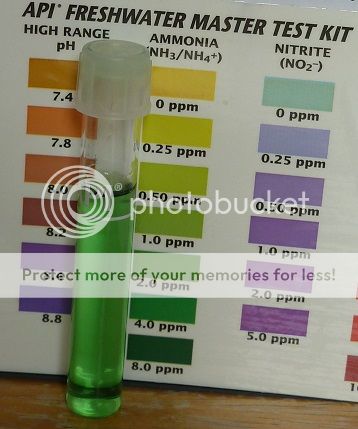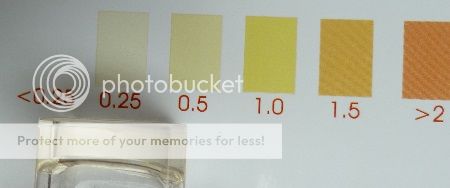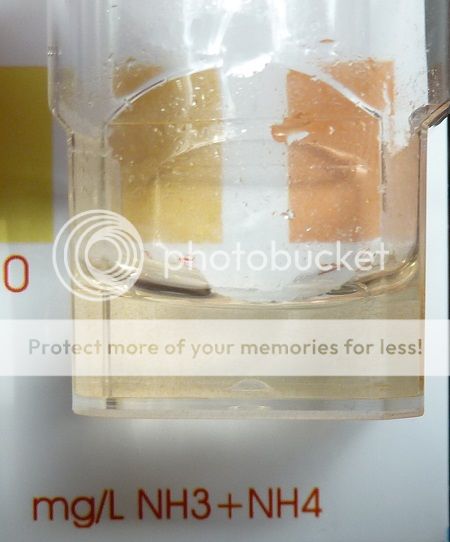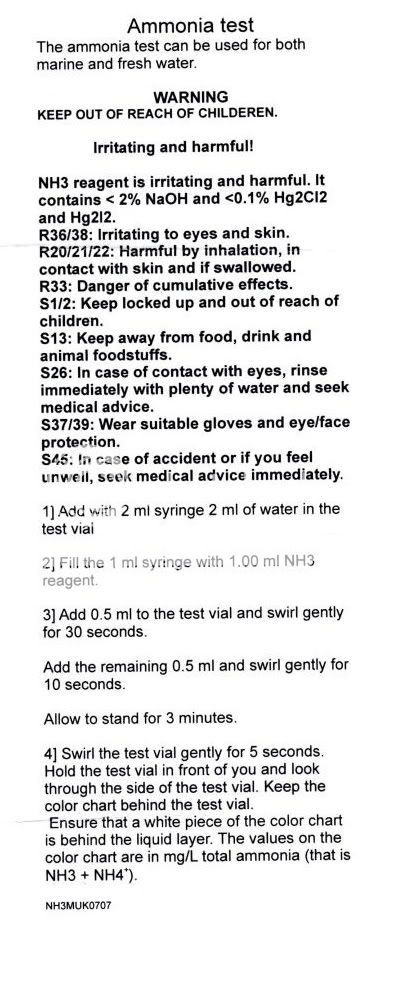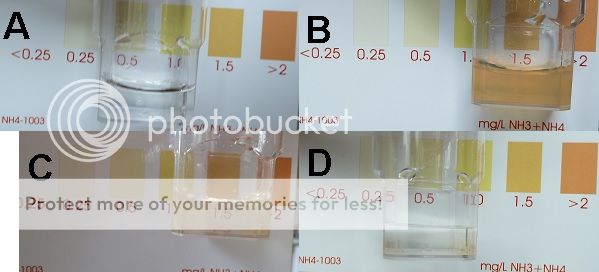TwoTankAmin
Fish Connoisseur
Ammonia- we talk about it a lot, we don't want it, but our bacteria do. How much is in any tank at any time?
Almost any fish keeper you can find probably owns an ammonia test kit. We all consider it to be an important parameter to measure in our tanks, especially during cycling. And we discuss the results, the problems with testing. There are countless discussions about things that cause false positives, about the accuracy of results or the methods for testing. But this only covers a small portion of the world of testing.
Laboratory and field researchers at companies and universities are also testing, and they are using completely different equipment for this than we in the hobby normally use in our tanks. the one thing almost no fish keeper will dispute is that our kits are not really accurate and the lab grade ones are. But how much do most us us really know?
Almost all of test ammonia using a test kit which is uses the salicylate method of testing. But do most of us know anything more than add so many drops of solution 1 and mix, then add so many drops of solution two and mix. Then we wait some number of minutes and compare the color in the little vial to the color on a card. And we all know about the issues with color interpretaion and comparison.
In order to come to grips with ammonia testing the first step is to know exactly what is actually going on in a salicylate test:
 /www.flowinjection.com/methods/ammonia.aspx
/www.flowinjection.com/methods/ammonia.aspx
In the most expensive test kits the color is read electronically- no human color perceptions are involved. But basically the more ammonia that is present, the darker the color.
Now one might think that something like and API or Tetra or SeaChem kit are doing the same thing the fancy lab kits are since they both use the salicylate method. But they stop looking so similar when one examines how a lab grade kits is used. For example, Hach Company's salycilate kit requires 3 minutes of wait after the first reagent is added and then a 15 minute wait after the 2nd. The total wait time on and API ammonia test is 5 minutes.
The Hach kit comes with a table and some formulas and the following instructions:
 /www.hach.com/asset-get.download.jsa?id=7639982686
/www.hach.com/asset-get.download.jsa?id=7639982686
So my first question is, why do the aquarium kits need so little sitting time compared to the lab grade tests? My second question is since the even higher quality lab grade ammonia kits prefer to use an expensive photometer to read the results instead of a human visual comparison, how accurate can the colors and our interpretations of them be on the aquarium grade kits? When one gets into the really sophisticated end of testing the equipment stars to be priced in the $1,000 and up range.
But it only beginning to get interesting because there are a number of things that can cause inaccurate readings when using the salycilate method, even with a lab grade kit.
 /www.flowinjection.com/methods/ammonia.aspx
/www.flowinjection.com/methods/ammonia.aspx
Its doesn't end here. Because the first step in the test is basically to add chlorine, sites which explain how to DIY salicylate testing all explain the the test solution 1 should be refreshed daily as it degrades. Since it is basically chlorine, we know it out-gasses and loses strength. Does anybody think that the #1 bottle of solution in aquarium level kits is airtight? And even if one can get it well sealed by firmly closing the cap, how often might we not turn it quite all the way?
What I am seeing in all this is that testing for ammonia (and likely most other things) with the more commonly used aquarium kits is pretty much a coin toss as to how meaningful any result may be. How can a $6 vs $85 ammonia test kit be measuring with the same degree of accuracy or reliability? And there is certainly no comparison to those that can run into the many hundreds or even thousands of dollars.
While looking for information I ran across a site that gave directions for making ammonia test solutions to check how accurate a given kit/tester may be. I forgot to bookmark it (DOH). But I do remember it saying in a pinch one can use the same ammonia this site recommends for fishless cycling in the UK. So if folks wanted to they could use a clean bucket of water (a gallon or two), add the amount of ammonia based on the site calculator here to dose to 2 ppm, stir it up and then test with your kit. You can dilute the solution to test at lower levels. Even better would be to use deionized water. I will try to track down the site with the directions.
I just poked around the API site looking to see what is in their two bottles for testing ammonia, One bottle basically contains sodium hydroxide (lye) and sodium hypochlorite (chlorine) while the other basically contains sodium salicylate and polyethylene glycol. The curious can find the information here http /cms.marsfishcare.com/files/msds/ammonia_test_122309.pdf
/cms.marsfishcare.com/files/msds/ammonia_test_122309.pdf
Almost any fish keeper you can find probably owns an ammonia test kit. We all consider it to be an important parameter to measure in our tanks, especially during cycling. And we discuss the results, the problems with testing. There are countless discussions about things that cause false positives, about the accuracy of results or the methods for testing. But this only covers a small portion of the world of testing.
Laboratory and field researchers at companies and universities are also testing, and they are using completely different equipment for this than we in the hobby normally use in our tanks. the one thing almost no fish keeper will dispute is that our kits are not really accurate and the lab grade ones are. But how much do most us us really know?
Almost all of test ammonia using a test kit which is uses the salicylate method of testing. But do most of us know anything more than add so many drops of solution 1 and mix, then add so many drops of solution two and mix. Then we wait some number of minutes and compare the color in the little vial to the color on a card. And we all know about the issues with color interpretaion and comparison.
In order to come to grips with ammonia testing the first step is to know exactly what is actually going on in a salicylate test:
From httpLow ammonium levels can be determined in FIA by using the salicylate method. The salicylate method is a variation of the Berthelot-Phenate
method but does not require the use and disposal of toxic phenol. The salicylate method involves a three-step reaction sequence. The first reaction step involves the conversion of ammonia to monochloroamine by the addition of chlorine. The monochloroamine then reacts with salicylate to form 5-aminosalicylate. Finally, the 5-aminosalicylate is oxidized in the presence of sodium nitroferricyanide to form a blue-green colored dye that absorbs light at 650nm.
 /www.flowinjection.com/methods/ammonia.aspx
/www.flowinjection.com/methods/ammonia.aspxIn the most expensive test kits the color is read electronically- no human color perceptions are involved. But basically the more ammonia that is present, the darker the color.
Now one might think that something like and API or Tetra or SeaChem kit are doing the same thing the fancy lab kits are since they both use the salicylate method. But they stop looking so similar when one examines how a lab grade kits is used. For example, Hach Company's salycilate kit requires 3 minutes of wait after the first reagent is added and then a 15 minute wait after the 2nd. The total wait time on and API ammonia test is 5 minutes.
The Hach kit comes with a table and some formulas and the following instructions:
From httpAmmonia exists in water in two forms, un-ionized ammonia (NH3) and the ammonium ion (NH4+). NH3 is toxic to fish, while NH4+ is nontoxic (except at extremely high levels). At a neutral pH and ambient temperature, almost all of the ammonia exists as NH4+. As the pH and temperature increase, the proportion of NH3 increases (see Table 1). This test kit measures both ammonia forms as ammonia nitrogen (NH3–N). Use Table 1 and equations (1) and (2) to determine the amount of NH3 and NH4+ in the sample.
 /www.hach.com/asset-get.download.jsa?id=7639982686
/www.hach.com/asset-get.download.jsa?id=7639982686So my first question is, why do the aquarium kits need so little sitting time compared to the lab grade tests? My second question is since the even higher quality lab grade ammonia kits prefer to use an expensive photometer to read the results instead of a human visual comparison, how accurate can the colors and our interpretations of them be on the aquarium grade kits? When one gets into the really sophisticated end of testing the equipment stars to be priced in the $1,000 and up range.
But it only beginning to get interesting because there are a number of things that can cause inaccurate readings when using the salycilate method, even with a lab grade kit.
From httpSulfide will intensify the blue-green color and should be removed from the sample if possible. Hydrazine and glycine like sulfide can also intensify the color. High sample turbidity will give significant erroneous results and may need to be pre-filtered or run utilizing a different ammonia method. Iron will also interfere with the analysis, but can be eliminated by doping the calibrations samples with the same level of iron present in the sample. To a lesser extent the following ions may also interfere: sulfates (>300 ppm), phosphates (>100 ppm), nitrates (>100 ppm), nitrites (>12 ppm), calcium (>1000 ppm) and magnesium (>6,000 ppm).
 /www.flowinjection.com/methods/ammonia.aspx
/www.flowinjection.com/methods/ammonia.aspxIts doesn't end here. Because the first step in the test is basically to add chlorine, sites which explain how to DIY salicylate testing all explain the the test solution 1 should be refreshed daily as it degrades. Since it is basically chlorine, we know it out-gasses and loses strength. Does anybody think that the #1 bottle of solution in aquarium level kits is airtight? And even if one can get it well sealed by firmly closing the cap, how often might we not turn it quite all the way?
What I am seeing in all this is that testing for ammonia (and likely most other things) with the more commonly used aquarium kits is pretty much a coin toss as to how meaningful any result may be. How can a $6 vs $85 ammonia test kit be measuring with the same degree of accuracy or reliability? And there is certainly no comparison to those that can run into the many hundreds or even thousands of dollars.
While looking for information I ran across a site that gave directions for making ammonia test solutions to check how accurate a given kit/tester may be. I forgot to bookmark it (DOH). But I do remember it saying in a pinch one can use the same ammonia this site recommends for fishless cycling in the UK. So if folks wanted to they could use a clean bucket of water (a gallon or two), add the amount of ammonia based on the site calculator here to dose to 2 ppm, stir it up and then test with your kit. You can dilute the solution to test at lower levels. Even better would be to use deionized water. I will try to track down the site with the directions.
I just poked around the API site looking to see what is in their two bottles for testing ammonia, One bottle basically contains sodium hydroxide (lye) and sodium hypochlorite (chlorine) while the other basically contains sodium salicylate and polyethylene glycol. The curious can find the information here http
 /cms.marsfishcare.com/files/msds/ammonia_test_122309.pdf
/cms.marsfishcare.com/files/msds/ammonia_test_122309.pdf


